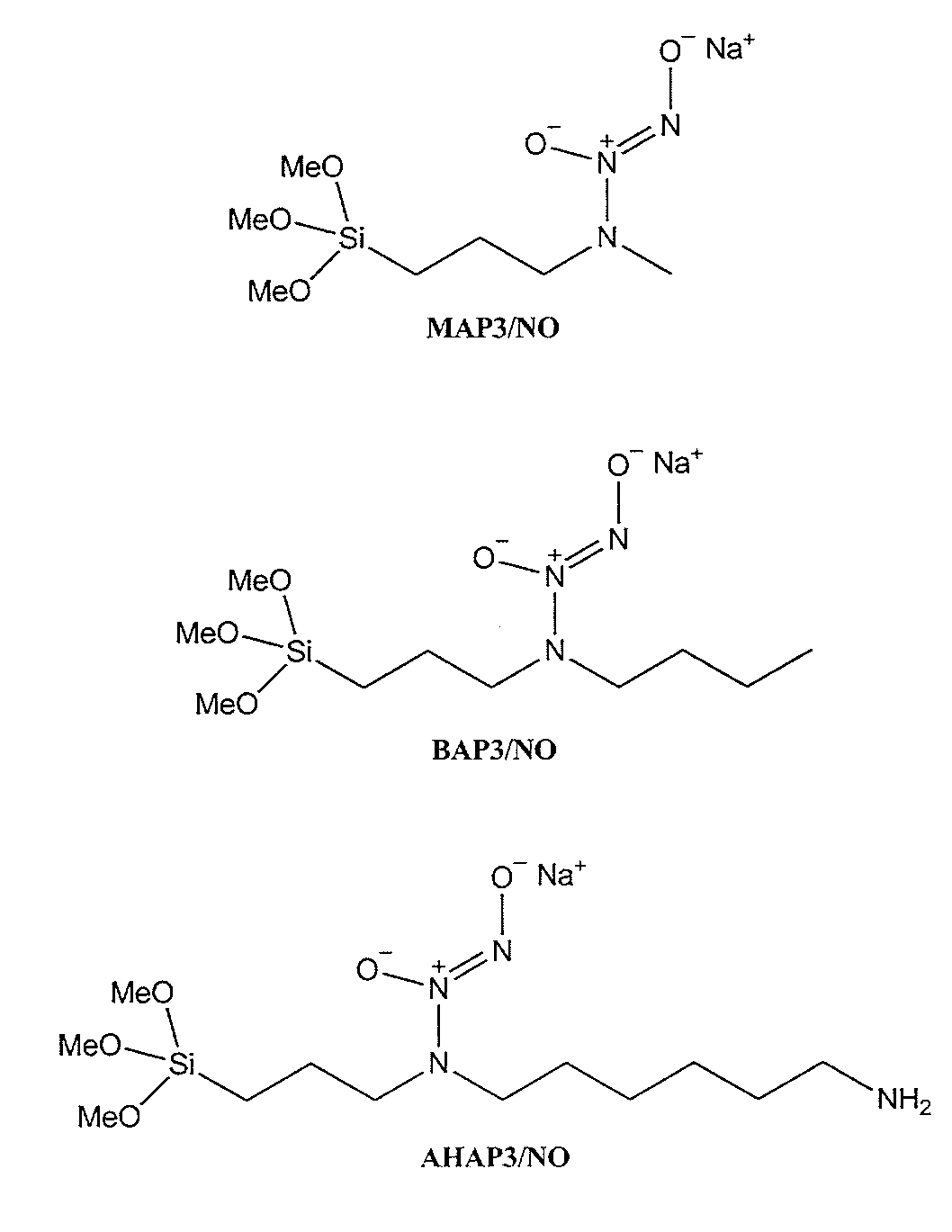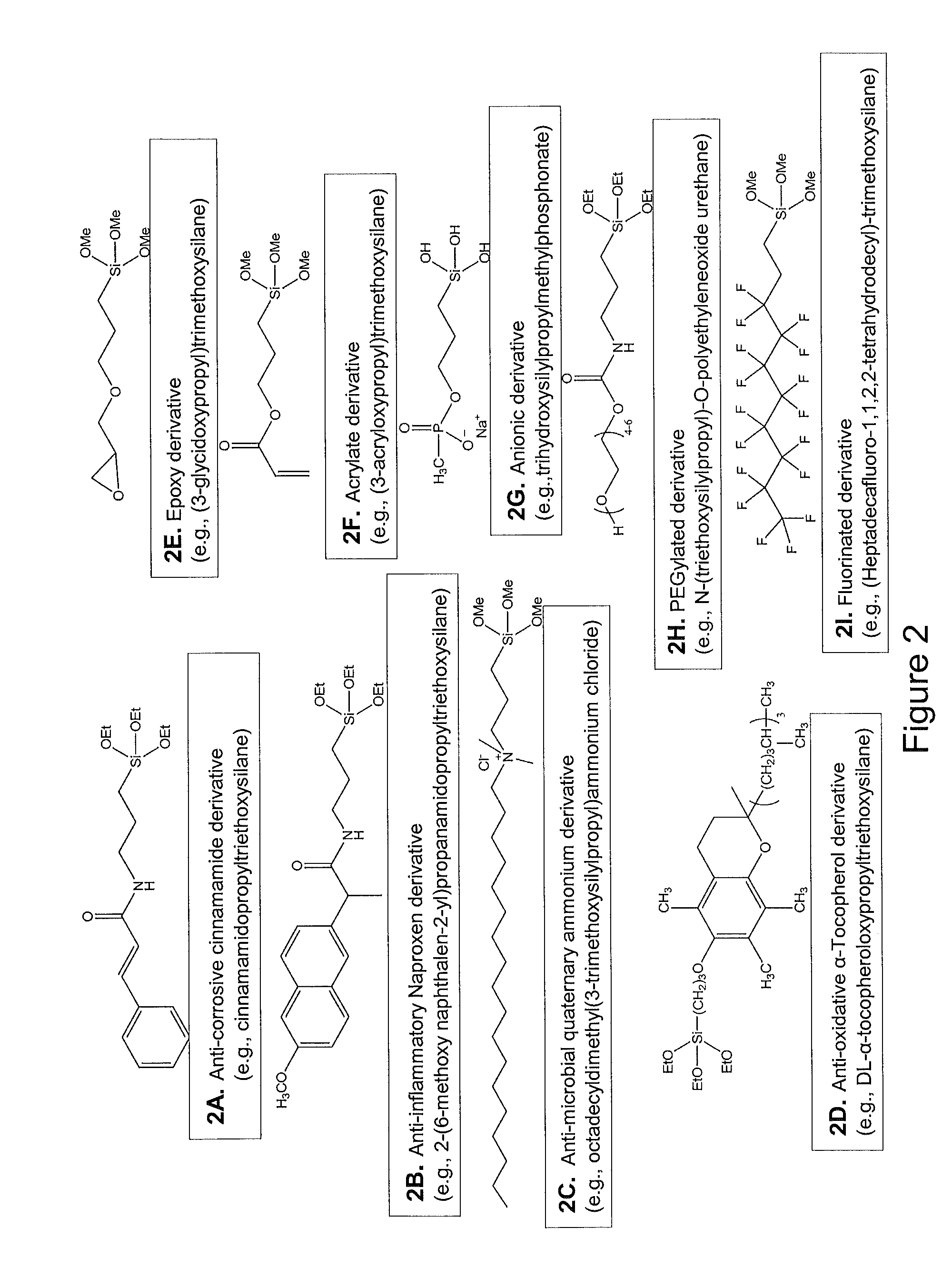Nitric oxide-releasing coatings
a technology of nitric oxide and coating materials, applied in the field of coating materials, can solve the problems of ineffective tissue integration, high cost, and high cost, and achieve the effect of excellent no storage capability
- Summary
- Abstract
- Description
- Claims
- Application Information
AI Technical Summary
Benefits of technology
Problems solved by technology
Method used
Image
Examples
example 1
Precharging Aminosilanes
[0087]Sodium methoxide (325 mg) was dissolved in ethanol (3 mL; absolute) and methanol (0.75 mL) via sonication for 5 min. Butylamino-propyltrimethoxysilane (nBAP-3) (1.185 mL) was added and vortexed 1 min to mix. The mixture was divided among two 6 mL glass vials equipped with stir bars, which were then placed in a Parr hydrogenation bomb and affixed to a NO charging apparatus. While stirring, the Parr hydrogenation bomb was flushed with 5 atm of argon three times in rapid succession and then 3 times for 10 minutes each. The bomb was then pressurized with 5 atm of NO (99.5%; further purified over potassium hydroxide for >3 hr) for 3 days to modify the secondary amines to diazeniumdiolates. Following NO modification, the bomb was flushed thrice quickly with argon (5 atm). The resulting BAP-3 / NO solution was used immediately.
example 2
Glass Slide Pre-Treatment
[0088]Glass slides (9×12.5 mm) were cleaned by sonication in ethanol (absolute) for 20 minutes each. The slides were then gently dried with a stream of nitrogen and then soaked in 10% nitric acid (v / v, H2O) at 80° C. for 20 min, followed by rinsing with distilled / deionized water. The slides were then modified with (3-aminopropyl)trimethoxysilane, APTMS, by soaking in a solution of 10% APTMS (v / v, H2O, pH 7) at 80° C. for 90 min, and then rinsed with distilled / deionized water. Finally, the modified slides were soaked in 10% glutaraldehyde (v / v, H2O) at room temp for 60 min, rinsed with distilled / deionized water, and dried with a stream of nitrogen. Slides were used within 24 hr of preparation.
example 3
Titanium Pre-Treatment
[0089]10 mm×10 mm×1 mm titanium coupons are cut from a sample of titanium sheet metal via shearing. The titanium coupons are sonicated at 120% power for 20 min in ethanol, followed by 20 min. in acetone, and then 20 mins in deionized water. The coupons are then etched in a 50% (v / v) concentrated sulfuric acid solution in water for 30 min at 60° C. Following thorough rinsing with deionized water, the etched titanium coupons are then sonicated in deionized water for 20 min. Then, they are placed in a “piranha” solution (7.5 mL of conc. sulfuric acid: 2.5 mL of 30% hydrogen peroxide) for 10 minutes (for surface hydroxylation). The coupons are then rinsed multiple times with deionized water and then sonicated (2×) in deionized water for 10 min. Coupons are stored in deionized water. Prior to use, they are dried under flow of nitrogen.
PUM
| Property | Measurement | Unit |
|---|---|---|
| total thickness | aaaaa | aaaaa |
| total thickness | aaaaa | aaaaa |
| total thickness | aaaaa | aaaaa |
Abstract
Description
Claims
Application Information
 Login to View More
Login to View More - R&D
- Intellectual Property
- Life Sciences
- Materials
- Tech Scout
- Unparalleled Data Quality
- Higher Quality Content
- 60% Fewer Hallucinations
Browse by: Latest US Patents, China's latest patents, Technical Efficacy Thesaurus, Application Domain, Technology Topic, Popular Technical Reports.
© 2025 PatSnap. All rights reserved.Legal|Privacy policy|Modern Slavery Act Transparency Statement|Sitemap|About US| Contact US: help@patsnap.com



